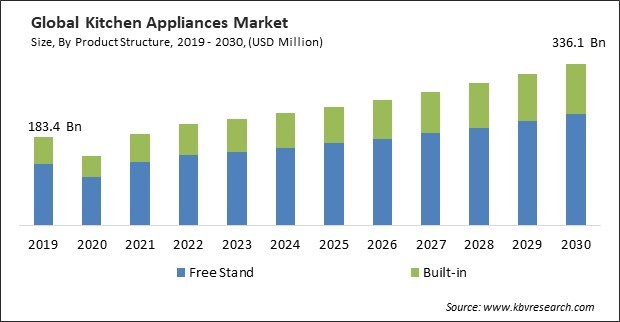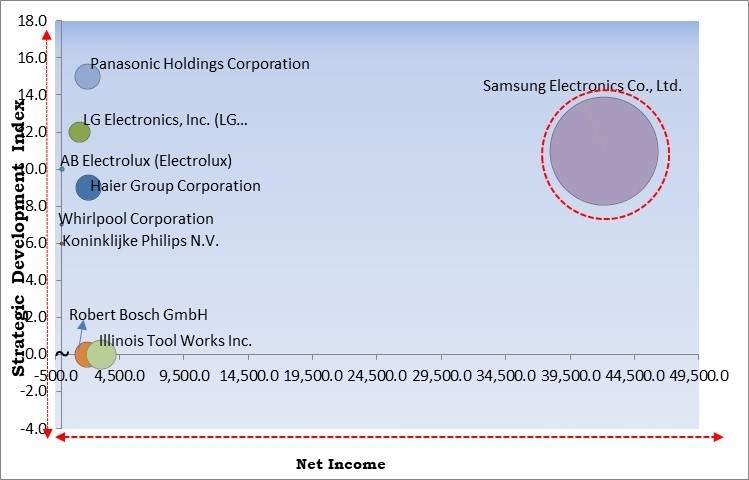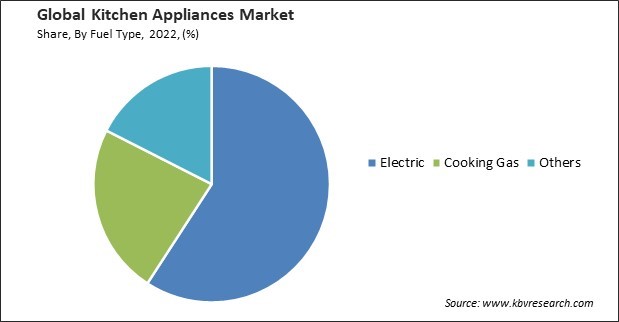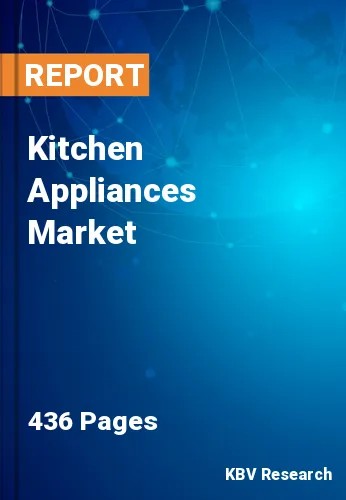The Global Kitchen Appliances Market size is expected to reach $336.1 billion by 2030, rising at a market growth of 6.2% CAGR during the forecast period. In the year 2022, the market attained a volume of 3,62,291.1 thousand Units experiencing a growth of 6.6% (2019-2022).
Energy-efficient refrigerators have features like better insulation, improved compressor technology, and advanced temperature control, reducing energy consumption while keeping food fresh. Therefore, Refrigerator segment would capture 2/5th share of the market by 2030. As a result, the need for more sustainable and cost-effective kitchen appliances continues to rise, manufacturers will likely invest in further innovation and product development in this sector, leading to continued market growth. Customers are becoming more knowledgeable about the benefits of energy-efficient appliances, increasing demand for these products.

The major strategies followed by the market participants are Product Launches as the key developmental strategy to keep pace with the changing demands of end users. For instance, In January, 2022, Whirlpool launched Air Fry Mode and Yummly Smart Thermometer connectivity oven. Through this launch, the company aimed to provide households with more ways to take care of each other. Moreover, In March, 2021, Royal Philips introduced grinder-HL7777/00, a high-performance silent mixer. This new product is revolutionized by Philips following insights from users that highlighted to Indian houses rapidly demanding mixer grinders, which would offer a household surrounding with less noise along with providing better performance.
Based on the Analysis presented in the KBV Cardinal matrix; Samsung Electronics Co., Ltd. is the major forerunner in the Market. In January, 2023, Samsung Electronics Co., Ltd. launched its Bespoke Home lineup, including a wider selection of Bespoke refrigerator types. The launched product would be created to meet a growing demand for customization and offer a new level of intelligent connectivity that empowers users to be more sustainable in the kitchen. Companies such as Panasonic Holdings Corporation, LG Electronics, Inc. (LG Corporation) and Haier Group Corporation are some of the key innovators in the Market.

Smart home appliances offer a high level of convenience by allowing users to control and monitor them remotely. This means one can adjust settings, turn appliances on or off, and receive status updates from anywhere, making daily life more convenient and efficient. Smart appliances can automate various household tasks, saving time for users. Many smart appliances are designed with energy-saving features. They can be programmed to manage during off-peak hours or automatically enter energy-saving modes when not in use. This not only saves energy but also reduces utility costs. Smart home appliances can be integrated into larger ecosystems, allowing users to create custom automation routines. The above factors will drive the market growth in the coming years.
The construction of new residential and commercial buildings results in installing kitchen appliances in these spaces. This includes ovens, refrigerators, cooktops, dishwashers, and more, driving demand for a wide range of kitchen appliances. Existing housing facilities, both residential and commercial, often undergo renovations and upgrades. During these projects, homeowners and businesses frequently invest in new kitchen appliances to modernize their spaces, improve energy efficiency, and enhance functionality. The ownership and management of rental properties, including apartments, condos, and commercial spaces, require the provision of kitchen appliances for tenants. Investors and property owners often invest in these appliances as part of their property management strategy. This trend supports the growth of the market.
Intense competition can result in imitation products that closely mimic the design and features of successful appliances. This can confuse consumers and make it difficult for innovative brands to stand out. In order to capture consumers' attention in a crowded market, companies may need to spend significant amounts on advertising and marketing efforts, increasing expenses. The existence of multiple competitors in the market can lead to fragmentation, with various brands vying for a market share. This fragmentation can make it challenging for smaller players to gain visibility and compete effectively. The above factors will decline the market growth in the coming years.
On the basis of product structure, the market is classified into built-in and free stand. The built-in segment recorded a remarkable revenue share in the kitchen appliance market in 2022. Built-in appliances offer a sleek, cohesive appearance that enhances the overall look and feel of the kitchen. They can be customized to match the cabinetry and kitchen decor. Built-in appliances offer flexibility in design and layout, permitting homeowners to create a kitchen that fits their needs and preferences. A kitchen with well-designed built-in appliances can add significance to a home and make it more appealing to potential buyers. Appliances integrated into cabinets reduce the risk of tripping hazards and provide a safer kitchen environment.
By fuel type, the market is categorised into electric, cooking gas, and others. In 2022, the electric segment registered the highest revenue share in the market. Electric appliances are known for their energy efficiency, converting electricity into usable energy with minimal waste. They are often designed to perform tasks quickly and with precision. Electric kitchen appliances are user-friendly and easy to operate, making meal preparation and cooking more convenient for individuals with varying levels of culinary expertise. These appliances can significantly reduce the time required for cooking and food preparation. They automate many tasks and processes, allowing them to multitask and save time in the kitchen.

Based on user application, the market is fragmented into commercial and household. The commercial segment garnered a significant revenue share in the kitchen appliance market in 2022. Commercial kitchens require appliances that can handle high volumes of food preparation efficiently. Appliances that can chop, blend, cook, or bake quickly and consistently are essential for meeting the demands of a busy restaurant or catering operation. Commercial kitchen appliances are built with health and safety regulations in mind. Increasing demand to replace aging appliances, shifting consumer preferences, and rising disposable income will all contribute to the growth of the residential market during the forecast period.
On the basis of product type, the market is segmented into refrigerator, cooking appliances, dishwasher, and others. In 2022, the refrigerator segment dominated the market with the maximum revenue share. There is a growing need in the commercial sector for food and beverage storage and merchandising purposes. Refrigeration prevents the proliferation of harmful pathogens and foodborne illnesses by keeping food at safe temperatures. It helps ensure that food remains safe for consumption. Many modern refrigerators come with adjustable shelves, compartments, and drawers, allowing consumers to customize the storage space and keep their food items organized. Additionally, the replacement of outdated products with newer, more advanced alternatives is expected to boost demand for these items in the future years.
| Report Attribute | Details |
|---|---|
| Market size value in 2022 | USD 210.5 Billion |
| Market size forecast in 2030 | USD 336.1 Billion |
| Base Year | 2022 |
| Historical Period | 2019 to 2021 |
| Forecast Period | 2023 to 2030 |
| Revenue Growth Rate | CAGR of 6.2% from 2023 to 2030 |
| Number of Pages | 436 |
| Number of Table | 853 |
| Quantitative Data | Volume in Thousand Units, Revenue in USD Billion, and CAGR from 2019 to 2030 |
| Report coverage | Market Trends, Revenue Estimation and Forecast, Segmentation Analysis, Regional and Country Breakdown, Competitive Landscape, Porter’s 5 Forces Analysis, Company Profiling, Companies Strategic Developments, SWOT Analysis, Winning Imperatives |
| Segments covered | Product Structure, Fuel Type, User Application, Product Type, Region |
| Country scope |
|
| Companies Included | Whirlpool Corporation, AB Electrolux, Haier Smart Home Co., Ltd. (Haier Group Corporation), Robert Bosch GmbH, Samsung Electronics Co., Ltd. (Samsung Group), Koninklijke Philips N.V., Panasonic Holdings Corporation, Morphy Richards (Guangdong Xinbao Electrical Appliances Holdings Co., Ltd), LG Electronics, Inc. (LG Corporation) and Illinois Tool Works, Inc. |
| Growth Drivers |
|
| Restraints |
|
Region-wise, the market is analysed across North America, Europe, Asia Pacific, and LAMEA. In 2022, the North America region generated the highest revenue share in the market. There is an increase in the adoption of smart kitchen appliances due to the rise in modular kitchens among consumers. Consumers wish to own kitchen appliances that are technology-driven and easy to operate. An increase in the working-class population fosters the demand for efficient kitchen appliances. This provides ample growth opportunities for the companies to launch innovative kitchen appliances in North America.
Free Valuable Insights: Global Kitchen Appliances Market size to reach USD 336.1 Billion by 2030
The market research report covers the analysis of key stake holders of the market. Key companies profiled in the report include Whirlpool Corporation, AB Electrolux, Haier Smart Home Co., Ltd. (Haier Group Corporation), Robert Bosch GmbH, Samsung Electronics Co., Ltd. (Samsung Group), Koninklijke Philips N.V., Panasonic Holdings Corporation, Morphy Richards (Guangdong Xinbao Electrical Appliances Holdings Co., Ltd), LG Electronics, Inc. (LG Corporation) and Illinois Tool Works, Inc.
By Product Structure (Volume, Thousand Units, USD Billion/Million, 2019-2030)
By Fuel Type (Volume, Thousand Units, USD Billion/Million, 2019-2030)
By User Application (Volume, Thousand Units, USD Billion/Million, 2019-2030)
By Product Type (Volume, Thousand Units, USD Billion/Million, 2019-2030)
By Geography (Volume, Thousand Units, USD Billion/Million, 2019-2030)
This Market size is expected to reach $336.1 billion by 2030.
Rising demand for smart home appliances are driving the Market in coming years, however, Intense competition between multiple competitors restraints the growth of the Market.
Whirlpool Corporation, AB Electrolux, Haier Smart Home Co., Ltd. (Haier Group Corporation), Robert Bosch GmbH, Samsung Electronics Co., Ltd. (Samsung Group), Koninklijke Philips N.V., Panasonic Holdings Corporation, Morphy Richards (Guangdong Xinbao Electrical Appliances Holdings Co., Ltd), LG Electronics, Inc. (LG Corporation) and Illinois Tool Works, Inc.
In the year 2022, the market attained a volume of 3,62,291.1 thousand Units experiencing a growth of 6.6% (2019-2022).
The Free Stand segment is generating the highest revenue in the Market by Product Structure in 2022;there by, achieving a market value of $230.7 Billion by 2030.
The North America region dominated the Market by Region in 2022, and would continue to be a dominant market till 2030;there by, achieving a market value of $108.9 Billion by 2030.
Our team of dedicated experts can provide you with attractive expansion opportunities for your business.

